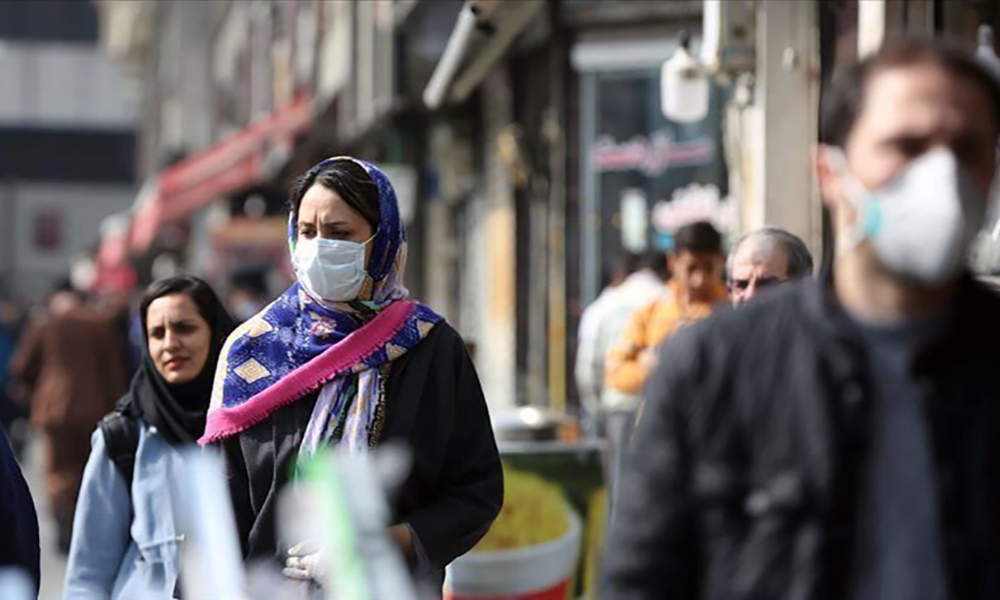COVID-19
China gives up reporting COVID-19 figures as virus rips across the country

China’s National Health Commission has announced it will no longer be publishing daily COVID-19 infection figures, as the virus rips through the population.
“As of today, we will no longer be releasing daily statistics on the pandemic, with any data released by the China Centers for Disease Control and Prevent for the purposes of reference and research,” the health ministry said on its official website.
The announcement came as China said Monday that beginning on Jan. 8, 2023 it will put an end to a mandatory quarantine on arrival for overseas travelers that had been in place since March 2020.
Officials had already warned that the development of the current outbreak had become “impossible to track” in the absence of mass testing, Radio Free Asia reported.
According to Bloomberg and other media outlets, Chinese authorities estimated in a closed internal meeting that around 250 million people in China were infected with COVID-19 this month.
Quoting data from the internal meeting of the National Health Commission of China on Wednesday, Bloomberg, the Financial Times, and Mingbo reported that approximately 248 million people in China, or about 18% of the country’s population of 1.4 billion, were infected with COVID-19 for the first twenty days of this month.
The Financial Times reported that Sun Yang, the deputy director of the National Bureau of Disease Control and Prevention, shared this information.
Bloomberg reported, “At the closed meeting, it was announced that an estimated 37 million people across China were infected just on Tuesday.” The Chinese government officially announced that 3,049 new cases were confirmed on that day.
The announcement came amid anecdotal evidence of skyrocketing death rates and overwhelming pressure on hospitals. A hospital in Taizhou city recently announced it had passed two million emergency room visits in recent days, while a video clip uploaded to social media by a Shanghai resident on Sunday showed hundreds of people lining up to get served at the city’s Baoxing Funeral Parlor in Shanghai, with the line stretching out of the gate and onto the street, RFA reported.
“This is what it’s like trying to take a number,” a person is heard saying on the audio. “You need to come early on Monday to get in line.”
An official in China’s political and legal committee system, the ruling Chinese Communist Party’s law enforcement hierarchy, said the massive pressure on crematoriums in the city had prompted municipal civil affairs bureau officials to take control of the sector.
Nobody is now allowed to transport the remains of their dead relatives to funeral homes, but must wait for them to be picked up by funeral home staff, the official told RFA on condition of anonymity.
The official said the current wave of infections is driven by government pressure to reboot the economy after months of damage under Communist Party leader Xi Jinping’s zero-COVID policy, and suggests the government is pursuing “herd immunity.”
“They are expressly telling people who have tested positive to go to work, to spread the infection as fast as possible,” the official said. “It’s like this all over the country now.”
In the absence of data, local governments are issuing estimates of case numbers based on computer modeling, with the eastern city of Qingdao reporting an estimated 500,000 new infections daily in the city.
A Qingdao resident who gave only the nickname John said that was likely an underestimate.
“I think it’s far more than 500,000 … it’s moving so fast, it’s like a deluge,” he said. “I never expected it to spread so fast.”
“There’s a hospital near where I live, with vehicles lined up on the street outside … bringing people for treatment,” he said. “Our whole family is infected.”
Meanwhile, authorities in the eastern province of Zhejiang estimated there were more than one million new infections across the province daily, with similar shortages of mortuary spaces and cremation slots at funeral homes.
Officials announced on Dec. 25 that new cases are likely to hit two million a day at the peak, which they expect will be around Jan. 1.
COVID-19
WHO declares end to COVID global health emergency

The World Health Organization said Friday that COVID-19 no longer qualifies as a global emergency, marking a symbolic end to the devastating coronavirus pandemic that triggered once-unthinkable lockdowns, upended economies and killed millions of people worldwide.
The announcement, made more than three years after WHO declared the coronavirus an international crisis, offers some relief, if not an ending, to a pandemic that stirred fear and suspicion, hand-wringing and finger-pointing across the globe, AP reported.
The U.N. health agency’s officials said that even though the emergency phase was over, the pandemic hasn’t finished, noting recent spikes in cases in Southeast Asia and the Middle East.
WHO says thousands of people are still dying from the virus every week, and millions of others are suffering from debilitating, long-term effects.
“It’s with great hope that I declare COVID-19 over as a global health emergency,” WHO Director-General Tedros Adhanom Ghebreyesus said.
“That does not mean COVID-19 is over as a global health threat,” he said, warning that new variants could yet emerge. Tedros noted that while the official COVID-19 death toll was 7 million, the real figure was estimated to be at least 20 million.
Tedros said the pandemic had been on a downward trend for more than a year, acknowledging that most countries have already returned to life before COVID-19.
He bemoaned the damage that COVID-19 had done to the global community, saying the pandemic had shattered businesses, exacerbated political divisions, led to the spread of misinformation and plunged millions into poverty.
When the U.N. health agency first declared the coronavirus to be an international crisis on Jan. 30, 2020, it hadn’t yet been named COVID-19 and there were no major outbreaks beyond China.
More than three years later, the virus has caused an estimated 764 million cases globally and about 5 billion people have received at least one dose of vaccine.
In the U.S., the public health emergency declaration made regarding COVID-19 is set to expire on May 11, when wide-ranging measures to support the pandemic response, including vaccine mandates, will end. Many other countries, including Germany, France and Britain, dropped most of their provisions against the pandemic last year.
When Tedros declared COVID-19 to be an emergency in 2020, he said his greatest fear was the virus’ potential to spread in countries with weak health systems.
Most recently, WHO has struggled to investigate the origins of the coronavirus, a challenging scientific endeavor that has also become politically fraught.
COVID-19
COVID-19 in Iran: Nearly 900 new cases, 24 deaths recorded

The Iranian health ministry announced on Sunday that more than 890 new cases of COVID-19 have been identified across the country during the past 24 hours, adding that 24 patients have died in the same period of time, Fars News Agency reported.
“A sum of 891 new patients infected with COVID-19 have been identified in the country based on confirmed diagnosis criteria during the past 24 hours,” the Iranian Health Ministry’s Public Relations Center said on Sunday, adding, “454 patients have been hospitalized during the same time span.”
The ministry’s public relations center said 611 people infected with COVID-19 are in critical condition.
COVID-19
China says 200 million treated, pandemic ‘decisively’ beaten

China says more than 200 million of its citizens have been diagnosed and treated for COVID-19 since it lifted strict containment measures beginning in November.
With 800,000 of the most critically ill patients having recovered, China has “decisively beaten” the pandemic, according to notes from a meeting of the ruling Communist Party’s all-powerful Politburo Standing Committee presided over by President and party leader Xi Jinping, AP reported.
China enforced some of the world’s most draconian lockdowns, quarantines and travel restrictions and still faces questions about the origins of the virus that was first detected in the central Chinese city of Wuhan in late 2019. Heavy-handed enforcement prompted rare anti-government protests and took a heavy toll on the world’s second-largest economy.
The official Xinhua News Agency quoted Xi as saying that policies to control the outbreak had been “entirely correct.” The abrupt lifting in November and December of the “zero COVID” policy that had sought to eliminate all cases of the virus led to a surge in infections that temporarily overwhelmed hospitals.
Case numbers have since peaked and life has largely returned to normal, although international travel in and out of China has yet to return to pre-pandemic levels.
China is now transitioning to a post-pandemic stage after a fight against the outbreak that was “extraordinary in the extreme,” Xinhua said.
The government will continue to “optimize and adjust prevention and control policies and measures according to the times and situations with a strong historical responsibility and strong strategic determination,” Xinhua said.
-

 Sport4 days ago
Sport4 days agoACL fever grows as fixtures finalized
-

 World4 days ago
World4 days agoUS will not take part in any Israeli retaliatory action against Iran
-

 Latest News4 days ago
Latest News4 days agoOver 50 people dead in traffic accidents over Eid
-

 Latest News4 days ago
Latest News4 days agoUS identifies Kabul airport suicide bomber
-

 Latest News4 days ago
Latest News4 days agoGood rains enable DABS to increase power production in Kabul
-

 Business4 days ago
Business4 days agoAfghanistan-Kazakhstan chamber of commerce opens in Herat
-

 World3 days ago
World3 days agoIsraeli military vows response to Iran attack as calls for restraint mount
-

 Latest News3 days ago
Latest News3 days agoPakistani police give Afghans in Balochistan one day to leave





























